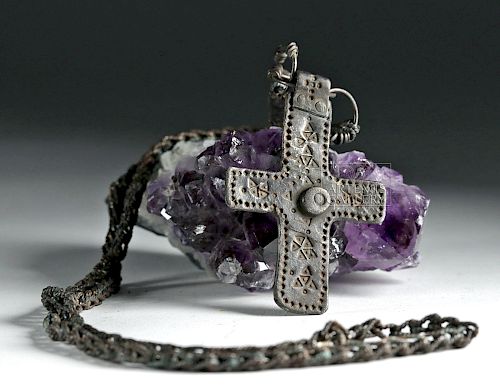Rare Viking Silver Necklace w/ Crucifix - 98.7 grams
Lot 86b
About Seller
Artemis Fine Arts
686 S Taylor Ave, Ste 106
Louisville, CO 80027
United States
Selling antiquities, ancient and ethnographic art online since 1993, Artemis Gallery specializes in Classical Antiquities (Egyptian, Greek, Roman, Near Eastern), Asian, Pre-Columbian, African / Tribal / Oceanographic art. Our extensive inventory includes pottery, stone, metal, wood, glass and textil...Read more
Categories
Estimate:
$6,000 - $9,000
Absentee vs Live bid
Two ways to bid:
- Leave a max absentee bid and the platform will bid on your behalf up to your maximum bid during the live auction.
- Bid live during the auction and your bids will be submitted real-time to the auctioneer.
Bid Increments
| Price | Bid Increment |
|---|---|
| $0 | $25 |
| $300 | $50 |
| $1,000 | $100 |
| $2,000 | $250 |
| $5,000 | $500 |
| $10,000 | $1,000 |
| $20,000 | $2,500 |
| $50,000 | $5,000 |
| $100,000 | $10,000 |
| $200,000 | $20,000 |
About Auction
By Artemis Fine Arts
May 10, 2018
Set Reminder
2018-05-10 10:00:00
2018-05-10 10:00:00
America/New_York
Bidsquare
Bidsquare : Fine Ethnographic / Asian / Ancient Art
https://www.bidsquare.com/auctions/artemis-gallery/fine-ethnographic-asian-ancient-art-3213
Featuring antiquities from around the world including Pre-Columbian, Tribal, Classical, Asian, so much more! Artemis Fine Arts info@artemisgallery.com
Featuring antiquities from around the world including Pre-Columbian, Tribal, Classical, Asian, so much more! Artemis Fine Arts info@artemisgallery.com
- Lot Description
Northern Europe, Viking/Norse culture, ca. 11th century CE. An incredible example of a heavy silver artifact from one of the pivotal moments in Viking history, the conversion from paganism to Christianity. A large cross, its face studded with a round boss at center and stamped with triangles down each arm, hangs from a trichinopoly chain, connected to highly abstract, zoomorphic finials at the end of the chain by a series of three looped silver wires. The cross, the terminals, and the chain are each examples of the amazing silverwork done by Viking artisans. The triangular stamps, each containing a granulated dot, are a classic symbol of Viking metalwork, especially silver. The delicate braiding of the chain is incredible. The terminals are made of sheet silver and are in two parts, with the upper part also stamped with triangles, and the lower part resembling a mask-like face with an elongated snout - perhaps a wolf. Size of cross: 2" W x 3" H (5.1 cm x 7.6 cm); length of chain: 29.5" (74.9 cm); 98.7 grams
A piece such as this would have been made in a specialized workshop centered around a hearth, probably using the lost wax casting technique. The important Viking metalworking shops correspond to their great trading ports and proto-urban centers - Birka, Helgo, Sigtuna, and Lund in Sweden, Ribe, Haithabu (Hedeby), and Fyrkat in Denmark, and Kaupang and Trondheim in Norway. Silver was the principal currency of the Viking world, which stretched from Russia to northern Canada at the height of their influence. In many places, the Vikings kept silver not as coins, but as jewelry, a wearable currency form that was not subject to the authority of a monarch or mint. One of the most common archaeological finds from the Viking period is a hoard of metal objects, often buried in the earth or deposited in bodies of water, like river beds. These are found in great quantities throughout the British Isles and the Nordic countries. A cross like this one may have been deposited in a hoard or buried in a grave, although that practice died out as the conversion to Christianity became more complete and bodies stopped being buried with grave goods.
Provenance: private New York, New York, USA collection
All items legal to buy/sell under U.S. Statute covering cultural patrimony Code 2600, CHAPTER 14, and are guaranteed to be as described or your money back.
A Certificate of Authenticity will accompany all winning bids.
We ship worldwide and handle all shipping in-house for your convenience.
#131102Dark patina on surface of chain and on cross. Chain has some small bends to a few of its links. Slight bending to form of cross. Amethyst in photo for support/display purposes only.Condition
- Shipping Info
-
All shipping is handled in-house for your convenience. Your invoice from Artemis Gallery will include shipping calculation instructions. If in doubt, please inquire BEFORE bidding for estimated shipping costs for individual items.
-
- Buyer's Premium



 EUR
EUR CAD
CAD AUD
AUD GBP
GBP MXN
MXN HKD
HKD CNY
CNY MYR
MYR SEK
SEK SGD
SGD CHF
CHF THB
THB














